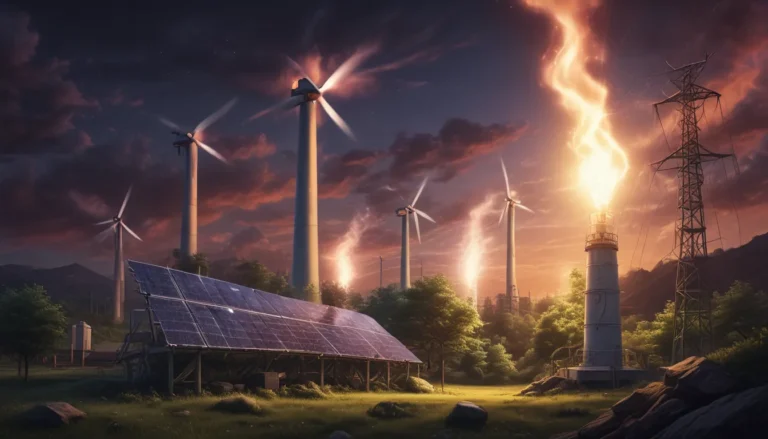A Note About Images: The images used in our articles are for illustration purposes only and may not exactly match the content. They are meant to engage readers, but the text should be relied upon for accurate information.
Have you ever gazed at the sky and wondered about the intricate processes that govern our weather patterns? Low-pressure systems are a fundamental aspect of meteorology that influences the conditions we experience on a daily basis. These atmospheric phenomena create storms, rainfall, and even hurricanes, shaping the world around us in profound ways.
In this comprehensive guide, we will explore 15 intriguing facts about low-pressure systems, shedding light on their formation, effects, and significance. From understanding the role they play in global weather patterns to unraveling the complexities of their dynamics, we invite you on a journey to delve into the captivating world of low-pressure systems. Whether you are a weather enthusiast, a budding meteorologist, or simply curious about the wonders of the atmosphere, this article is sure to expand your knowledge and appreciation for these dynamic weather systems.
Unveiling the Secrets of Low-Pressure Systems
Low-pressure systems are weather phenomena characterized by a center of low atmospheric pressure. These systems create unsettled weather conditions as air converges and rises, leading to the formation of various weather events such as storms, rainfall, and strong winds. Understanding the mechanisms behind low-pressure systems is crucial for accurate weather forecasting and predicting hazardous weather conditions. These dynamic weather systems continue to fascinate meteorologists with their complex dynamics and the challenges they pose in weather prediction.
The Birth of a Low-Pressure System
Low-pressure systems typically form when warm air rises and creates an area of lower pressure at the surface. This phenomenon often occurs when cold and warm air masses collide, setting the stage for the development of dynamic atmospheric conditions. As air converges towards the center of the low-pressure system, it creates upward vertical motion, leading to instability in the atmosphere.
The Dance of Wind Patterns
In the Northern Hemisphere, low-pressure systems exhibit counterclockwise rotation, a phenomenon known as the Coriolis effect. This rotation is a result of the Earth’s rotation and influences the direction of airflow within the system. The pressure gradient within low-pressure systems also plays a significant role in determining wind patterns, as air flows from areas of higher pressure towards the center, generating strong winds and atmospheric circulation.
A Symphony of Weather Events
Low-pressure systems are responsible for the formation of a wide range of weather phenomena, including storms, rainfall, and strong winds. These systems often develop along frontal boundaries, where warm and cold air masses collide, creating the ideal conditions for atmospheric lifting and cloud formation. The convergence of warm, moist air within low-pressure systems provides a fertile environment for storm development, leading to the creation of intense weather events such as hurricanes and typhoons.
A Lifeline for Climate Variability
The impact of low-pressure systems extends far beyond individual weather events, playing a crucial role in climate variability and global weather patterns. These systems contribute to atmospheric circulation and the redistribution of heat and moisture across the planet, influencing regional climate patterns and weather conditions. By understanding the behavior and movement of low-pressure systems, meteorologists can gain valuable insights into long-term climate trends and weather forecasting.
Unraveling the Mysteries of Low-Pressure Systems
As we journey through the fascinating world of low-pressure systems, we discover the intricate processes that govern our weather patterns and shape the world around us. From their formation over warm oceanic areas to their pivotal role in storm development, these dynamic weather systems continue to captivate us with their complexity and significance. By exploring the mysteries of low-pressure systems, we gain a deeper appreciation for the wonders of the atmosphere and the interconnectedness of our planet’s weather systems.
Embracing the Wonder of Weather
The next time you observe dark clouds gathering or feel a drop in air pressure, take a moment to appreciate the intricate dance of atmospheric forces at play. A low-pressure system might be orchestrating the atmospheric symphony, shaping the weather conditions that surround us. By embracing the wonder of weather phenomena like low-pressure systems, we open our minds to the beauty and complexity of the natural world, inviting us to explore, learn, and marvel at the forces that govern our planet.
Conclusion: A World of Weather Wonders
Low-pressure systems are a testament to the intricate processes that govern our weather patterns and shape the world we inhabit. From their role in storm development to their influence on global climate patterns, these dynamic weather systems hold a wealth of knowledge and mysteries waiting to be uncovered. By delving into the world of low-pressure systems, we gain a deeper understanding of the forces that shape our atmosphere and influence our daily lives.
As we navigate the vast expanse of meteorology and weather science, let us continue to explore, learn, and marvel at the wonders of the natural world. Low-pressure systems are just one piece of the intricate puzzle that is our planet’s weather system, inviting us to delve deeper into the mysteries of the atmosphere and uncover the secrets that lie hidden in the skies above.
We hope you enjoyed this deep dive into the captivating world of low-pressure systems. Remember, the beauty of our planet’s weather phenomena is all around us, waiting to be discovered and appreciated. Stay curious, stay engaged, and continue to unravel the mysteries of the atmosphere as we journey through the wonders of weather together.






